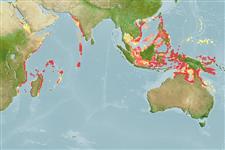Common names from other countries
Environment: milieu / climate zone / depth range / distribution range
Οικολογία
Υφαλόφιλο(α); εύρος βάθους 0 - 40 m (Ref. 848). Tropical; 23°N - 27°S, 34°E - 154°E (Ref. 848)
Indo-West Pacific.
Length at first maturity / Μέγεθος / Βάρος / Age
Maturity: Lm ? range ? - ? cm
Colony: often encrusting, becoming submassive. Corallites: angular, with a uniform appearance. Usually thin walls. Strongly alternating long and short septa. Well developed paliform lobes, forming a neat crown. Color: uniform pale brown or greenish-brown (Ref. 848).
Occurs in shallow reef environments (Ref. 848). On back and foreslope, outer reef channel and lagoons (Ref. 98471).
Life cycle and mating behavior
Γεννητική Ωρίμανση | Αναπαραγωγή | Γεννοβολία | Αβγά | Γονιμότητα | Προνύμφες
Members of the class Anthozoa are either gonochoric or hermaphroditic. Mature gametes are shed into the coelenteron and spawned through the mouth. Life cycle: The zygote develops into a planktonic planula larva. Metamorphosis begins with early morphogenesis of tentacles, septa and pharynx before larval settlement on the aboral end.
Veron, J.E.N. 2000. (Ref. 848)
IUCN Red List Status (Ref. 130435)
CITES status (Ref. 108899)
Not Evaluated
Human uses
| FishSource |
Εργαλεία
Περισσότερες πληροφορίες
Age/SizeΑύξησηLength-weightLength-lengthΜορφολογίαΠρονύμφεςΑφθονία
Διαδικτυακές πηγές
Estimates based on models
Preferred temperature
(Ref.
115969): 27.5 - 29.1, mean 28.2 (based on 126 cells).
Price category
Unknown.
